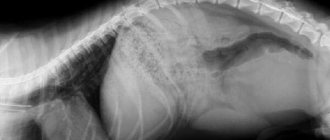The dog's body, just like the human body, is a unique system.
Thanks to the coordinated operation of the system, a large number of biochemical processes occur that make it possible to determine the level of not only physical, but also intellectual development of the animal.
Hormonal levels are of great importance for the proper functioning of the body.
When a dog’s endocrine system malfunctions, for example, with the development of Cushing’s syndrome, serious changes occur both physically and psychoemotionally, affecting the pet’s life expectancy.
How does the disease develop?
The mechanism of development of Cushing's syndrome is quite complex. The hormonal substance cortisol, produced by the adrenal tissues, is necessary for a number of functions:
- regulation of the blood coagulation system;
- maintaining normal blood pressure levels;
- elimination of inflammatory processes.
In a critical situation, during fear or excitement, the dog begins to produce increased cortisol. Cortisol is often referred to as the stress hormone. Cortisol is produced by the adrenal cortex, but production is regulated by another gland of the endocrine system - the pituitary gland. Thanks to the normal functioning of the pituitary gland, the level of cortisol in the bloodstream is clearly regulated.
If there are disturbances in the functions of the pituitary gland, there is an increase in cortisol in the blood and the development of Cushing's syndrome. The following factors may be the causes of the development of the pathological condition:
- damage to the pituitary gland by adenoma;
- development of malignant or benign neoplasms in the adrenal glands - carcinoma or adenoma;
- disruption of the endocrine system due to prolonged uncontrolled use of strong hormonal medications (iatrogenic hyperadrenocorticism).
Prevention
It is possible to prevent the disease; to do this, it is enough to give your pet sufficient physical activity and properly structure its diet. Routine examinations by a veterinarian can also detect the onset of the syndrome or identify it in the early stages.
Pet's future
Alas, this is not a curable disease and no one can avoid its consequences. Proper treatment will allow your pet to live 3 or 4 years without pain.
Don't be upset if this disease is confirmed. The dog has several more years of life ahead, and only you can determine what it will be like. Give her the opportunity to spend this time happily with her beloved owner.
Which dogs are at risk?
There is no particular gender or breed predisposition to the development of Cushing's syndrome in dogs. But experts note a tendency to frequently diagnose pathology in such dog breeds as:
- terriers;
- beagles;
- boxers;
- Shepherd dogs.
Owners of these dog breeds are advised to carefully monitor the health of their pets, paying special attention to the proper functioning of the endocrine system.
Veterinarians strongly recommend regularly taking special tests for early detection of possible pathological changes in the area of the adrenal glands or pituitary gland.
Tests and other diagnostic methods
Endocrine disease is diagnosed in four-legged patients mainly using laboratory methods. Clinical signs appear in the later stages of the pathology, when the metabolic failure has gone too far. If there is the slightest suspicion of Cushing's syndrome in dogs, blood tests may show increased amounts of glucose and hemoglobin. In the general analysis, erythrocytosis and an increased content of leukocytes are observed compared to the norm.
A biochemical examination of the blood of a sick pet with hyperadrenocorticism in some cases shows a high level of not only cortisol, but also cholesterol, alkaline phosphatase, and a decrease in urea levels. Urine tests indicate a decrease in its specific gravity.
Radiographic and x-ray examination methods will help confirm or refute the diagnosis. With their help, a veterinary specialist will identify the presence of osteoporosis and phenomena of adrenal mineralization. The methods also allow us to identify the neoplastic cause of the development of hyperadrenocorticism in dogs.
A highly effective method for diagnosing the condition of the pituitary gland and adrenal glands is an expensive computed tomography. With its help, a specialist can visualize a tumor and determine the presence of hyperplasia in the adrenal glands. In some cases, the animal undergoes magnetic tomography.
MRI
The arsenal of veterinary diagnostics also includes screening tests and the dexamethasone test, which allow diagnosing Cushing's syndrome in dogs. The screening test is based on determining the cortisol/creatinine ratio in the urine. The analysis is taken during spontaneous urination at home (without the influence of a stress factor).
The dexamethasone test is based on the difference in the level of cortisol in the blood before and after the introduction of an artificial hormone. This method is not suitable for identifying Cushing's syndrome caused by long-term use of glucocorticoids. In this case, the veterinarian uses a stimulation test with adrenocorticotropic hormone.
At what age is the likelihood of developing pathology highest?
Hyperadrenocorticism rarely develops in young dogs. In veterinary practice, Cushing's syndrome is diagnosed in pets after 7 years of age. It is believed that the pathological process develops in middle-aged and elderly animals. At the same time, hyperadrenocorticism due to problems in the adrenal glands develops in old animals after 10 years of age. At the same time, Cushing's syndrome due to disorders in the pituitary gland is diagnosed in dogs aged 7-9 years. But in some cases it occurs in dogs after 2 years.
Risk groups: which breeds are most susceptible to the disease?
Cushing-Itsenko syndrome can develop in dogs of absolutely any breed. However, statistics show that those at greatest risk are:
- boston terriers,
- poodles,
- german shepherds,
- boxers,
- terriers,
- beagles,
- retrievers,
- dachshunds.
Spontaneous hyperadrenocorticism, caused by a tumor in the pituitary gland, usually occurs in small dogs weighing no more than 20 kg (75% of cases). A special risk group is castrated and neutered animals. They are more susceptible to this disease than others, and symptoms appear faster. No relationship has been established between gender and the development of hyperadrenocorticism. Research on this issue is still underway, but statistics show that both males and females are equally susceptible to this disease.
The first symptoms of Cushing's syndrome in dogs
Hyperadrenocorticism develops gradually, but is characterized by a fairly specific clinical picture. The symptoms of the pathology are quite specific, and therefore a qualified veterinarian will immediately suspect the disease.
The first symptoms of Cushing's syndrome are not pronounced and may resemble manifestations of other diseases:
- the dog tries to drink more water;
- there is a frequent urge to urinate;
- disturbance of order in an adult animal - the dog cannot wait to go for a walk and makes a puddle at home;
- increased appetite;
- severe depression and apathy of the pet;
- sagging abdomen due to weakening muscle fibers;
- formation of areas of alopecia without severe itching;
- problems with coordination of movements;
- change in pet's behavior.
Hyperadrenocorticism is a systemic pathology that disrupts the functioning of most internal organs. Complications associated with Cushing's syndrome are often dangerous, for example, diabetes mellitus, high blood pressure, osteoporosis, and dysfunction of the reproductive organs.
Symptoms
The main danger on the path to recovery will be that pathology is practically not registered in the early stages. This or that symptom resembles other painful conditions during this period. Hyperadrenocorticism develops slowly.
Clinical picture:
- constant thirst is the first sign;
- loss of fur on the sides and belly;
- frequent urination and diarrhea;
- weight loss/gain with a normal diet;
- saggy belly due to muscle atrophy;
- peeling, thinning of the skin;
- lethargy, laziness, poor sleep;
- shortness of breath, sudden lameness.
An unpleasant change for owners is strange behavior. The once affectionate, cheerful and playful animal becomes disobedient, stubborn, and aggressive. The more progress the disease makes, the worse and more dangerous the dog’s condition. Constant stress has a lot to do with it.
Symptoms of Cushing's syndrome in dogs
With the development of hyperadrenocorticism, corresponding pathological changes occur in the body. The basic signs of the development of pathology are:
- Polydipsia - intense thirst. The animal drinks twice as much liquid as before.
- Changes in the tone of muscle fibers in the peritoneum. Fat deposits sag into the abdominal cavity, which leads to an increase in the size of the abdomen.
- Formation of areas of alopecia. Baldness in a dog with Cushing's syndrome is localized in the abdomen and sides. Over time, alopecia becomes generalized. The fur remains only in the area of the head and limbs.
- Lethargy and insomnia. A sick animal may become aggressive, have sleep disturbances and strange behavior.
- Hyperpigmentation of the skin. Hyperadrenocorticism in later stages is characterized by severe acne, skin pigmentation and flaking in areas devoid of fur.
- Dysfunction of the reproductive system. Females lose the ability to produce offspring. At the initial stages, the females' sexual cycle changes and signs of estrus disappear. With the development of Cushing's syndrome in males, atrophy of the appendages is noted.
A sick pet suffers from shortness of breath and also feels insatiable hunger. Due to the fact that Cushing's syndrome develops more often in older dogs, the symptoms of the pathology can be mistaken by the owner for the first signs of aging.
Itsenko-Cushing's disease
Itsenko-Cushing's disease (CUS) is a severe multisymptomatic disease of hypothalamic-pituitary origin, occurring with clinical manifestations of hypercortisolism, caused by the presence of a pituitary tumor or its hyperplasia and characterized by increased secretion of adrenocorticotropic hormone (ACTH), increased production of hormones by the adrenal cortex.
It is believed that with BIC, 85% of patients have an adenoma of the anterior pituitary gland (corticotropinoma), which, according to modern concepts, is the root cause of the disease. Corticotropinomas are characterized by small size. These are so-called microadenomas, located inside the sella turcica. Macroadenomas are much less common in NIC. In 15% of patients with BIC, diffuse or nodular hyperplasia of ACTH-producing cells (corticotrophs) is found. Rarely, in patients with BIC, a primary “empty” sella turcica is detected, or no changes in this area are detected on CT and MRI.
Etiology and pathogenesis
The cause of Itsenko-Cushing's disease has not been precisely established. NIC is more common in women and is rarely diagnosed in childhood and old age. In women, the disease develops between the ages of 20 and 40 years, and there is a dependence on pregnancy and childbirth, as well as on brain injuries and neuroinfections. In adolescents, BIC often begins during puberty.
It has been established that most of these tumors are monoclonal in nature, which indicates the presence of gene mutations in the original cells.
An important role in the oncogenesis of ACTH-producing pituitary tumors belongs to the abnormal sensitivity of the pituitary gland to hypothalamic factors. Strengthening the stimulating effect of neurohormones or weakening inhibitory signals is important in the formation and growth of pituitary tumors. Impaired action of inhibitory neurohormones, such as somatostatin and dopamine, may be accompanied by increased activity of stimulating neurohormones. In addition, there is evidence that uncontrolled cellular proliferation of pituitary tumors may result from disruption of growth factors.
A potential mechanism for the development of corticotropin syndrome may be spontaneous mutation of the CRH receptor or vasopressin genes.
Autonomous secretion of ACTH by the tumor leads to hyperfunction of the adrenal cortex. Therefore, the main role in the pathogenesis of BIC is given to increased function of the adrenal cortex. In the ACTH-dependent form of Cushing's disease, there is an increase in the functional activity of all three zones of the adrenal cortex: changes in the cells of the zona fasciculata lead to hypersecretion of cortisol, glomerular - to an increase in aldosterone, and reticularis - to increased synthesis of dehydroepiandrosterone (DHES).
Itsenko-Cushing's disease is characterized not only by an increase in the functional state of the adrenal cortex, but also by an increase in their size. In 20% of cases, secondary adenomas of small size (1–3 cm) are found against the background of adrenal hyperplasia.
With corticotropinomas, in addition to hypersecretion of ACTH, dysfunction of pituitary hormones is observed. Thus, basal secretion of prolactin in patients with NIC is normal or slightly increased. The somatotropic function of the pituitary gland in patients with corticotropinomas is reduced. Stimulus tests with insulin hypoglycemia, arginine and L-Dopa showed a decrease in GH reserves in Cushing's disease. The level of gonadotropic hormones (LH, FSH) in patients is reduced. This is due to the direct suppressive effect of excess endogenous corticosteroids on the secretion of releasing hormones by the hypothalamus.
Clinical picture
The clinical picture of Itsenko-Cushing's disease is caused by excessive secretion of corticosteroids and, first of all, glucocorticoids. An increase in body weight is characterized by a peculiar (“Cushingoid” type of obesity) uneven redistribution of subcutaneous fat in the region of the shoulder girdle, supraclavicular spaces, in the region of the cervical vertebrae (“menopausal hump”), abdomen, and with relatively thin limbs. The face becomes round (“moon-shaped”), the cheeks become crimson-red (“matronism”). In addition, with BIC, trophic changes in the skin are observed. Upon examination, the skin is thinned, dry with a tendency toward hyperkeratosis and has a purplish-cyanotic color. On the hips, chest, shoulders, and abdomen, peculiar stretch marks (striae) of a red-violet color appear. The nature of striae is “minus” tissue. These stretch marks are different from the pale or pink stretch marks that occur with obesity, pregnancy or childbirth. The appearance of stretch marks in BIC is associated with a disorder of protein metabolism (protein catabolism), as a result of which the skin becomes thinner. The presence of hematomas in minor injuries is a consequence of increased capillary fragility and thinning of the skin. Along with this, there is hyperpigmentation of the skin in areas of friction (neck, elbow joints, armpits). Women often experience increased hair growth (hirsutism) on the face (mustache, beard, sideburns) and chest. Sexual disorders in the form of secondary hypogonadism are one of the early symptoms of BIC.
In the symptom complex of BIC, the most significant in the clinical picture of the disease is damage to the cardiovascular system. The combination of arterial hypertension with metabolic disorders in the heart muscle leads to chronic circulatory failure and other changes in the cardiovascular system. Myopathy is often a characteristic symptom of hypercortisolism, which is expressed by degenerative muscle changes and hypokalemia. Atrophic processes affecting the striated and muscular systems are especially noticeable in the upper and lower extremities (“thinning” of the arms and legs). Atrophy of the muscles of the anterior abdominal wall leads to an enlarged abdomen.
The potassium content in erythrocytes and muscle tissue (including the myocardium) is significantly reduced. Disorders of electrolyte metabolism (hypokalemia and hypernatremia) underlie electrolyte-steroid cardiopathy and myopathy. With NIC, carbohydrate metabolism disorders of varying severity are observed in a large number of patients. At the same time, 70–80% of patients have impaired glucose tolerance, and the rest have type 2 diabetes mellitus. Clinical manifestations of diabetes are characterized by hyperinsulinemia, insulin resistance and lack of tendency to ketoacidosis. Diabetes, as a rule, has a favorable course, and to compensate for it, it is enough to prescribe a diet and oral hypoglycemic drugs.
Secondary immunodeficiency is manifested by pustular (acne) or fungal lesions of the skin and nail plates, trophic ulcers of the legs, a long period of healing of postoperative wounds, chronic and difficult to treat pyelonephritis. Encephalopathy in the form of changes in the autonomic nervous system in NIC is pronounced and diverse. Autonomic dystonia syndrome is characterized by emotional and personal changes: from mood and sleep disturbances to severe psychosis.
Systemic osteoporosis is a common and often severe manifestation of hypercortisolism in BIC at any age. Osteoporosis is a cause of pain in the spine, often leading to a decrease in the height of the vertebral bodies and spontaneous fractures of the ribs and vertebrae.
Depending on the severity of hypercortisolism and the formation of clinical symptoms, several degrees of severity of BIC are distinguished. The mild form is characterized by moderate severity of symptoms of the disease; medium - the severity of all symptoms in the absence of complications. The severe form is characterized by the severity of symptoms and the presence of complications (cardiopulmonary failure, steroid diabetes, progressive myopathy, pathological fractures, severe mental disorders). Depending on the rate of increase in clinical symptoms, a distinction is made between rapidly progressive (three to six months) and torpid course of the disease, which is manifested by a relatively slow (from one year or more) development of hypercortisolism.
If NIC is suspected, it is necessary to check whether the patient has hypercortisolism, then carry out a differential diagnosis of forms of hypercortisolism (NIC, ACTH-ectopic syndrome, Itsenko-Cushing syndrome), similar syndromes (obesity, metabolic syndrome, pubertal-adolescent dyspituitarism, alcoholic liver damage) and establish the localization of the main pathological process.
Diagnosis and differential diagnosis
If Itsenko-Cushing's disease is suspected, after collecting an anamnesis and clinical examination in all patients, it is necessary to confirm the presence of hypercortisolism using laboratory diagnostic methods. At the first stage, increased production of cortisol is detected. For this purpose, the daily rhythm of cortisol secretion in the blood plasma is determined in the morning (8.00-9.00) and in the evening (23.00-24.00). Patients with BIC are characterized by an increase in the morning level of cortisol in the blood plasma, as well as a disturbance in the rhythm of cortisol secretion, i.e., at night or in the evening, the level of cortisol remains elevated. Determination of daily excretion of free cortisol in urine is also a necessary laboratory diagnostic method to confirm hypercortisolism. The level of free cortisol in urine is determined by the RIA method. For healthy individuals, cortisol levels range from 120 to 400 nmol/s. In patients with BIC, the excretion of cortisol in daily urine is increased.
In doubtful cases, a small test with dexamethasone is performed for differential diagnosis between pathological endogenous and functional hypercortisolism. It is based on the suppression of endogenous ACTH production by high concentrations of corticosteroids according to the feedback principle. If cortisol secretion does not decrease by 50% or more from the initial level, this indicates the presence of hypercortisolism.
In this way, differential diagnosis of pathological and functional hypercortisolism is carried out.
If increased cortisol production is detected, it is necessary to carry out the next stage of examination - differential diagnosis between the forms of endogenous pathological hypercortisolism (BIK, SIC, ACTH-ectopic syndrome), Itsenko-Cushing's disease, ACTH-ectopic syndrome and Itsenko-Cushing syndrome. This stage of the examination includes determining the rhythm of ACTH secretion in the blood plasma and conducting a large test with dexamethasone.
BIC is characterized by normal or increased (up to 100–200 pg/ml) morning ACTH levels and no decrease at night. In ACTH-ectopic syndrome, ACTH secretion is increased and can range from 100 to 200 pg/ml and higher, and there is also no rhythm of its secretion. In ACTH-independent forms of hypercortisolism (Cushing's syndrome, macro- or micronodular adrenal dysplasia), the morning ACTH content is usually reduced in the absence of a rhythm of its secretion.
A large dexamethasone test is currently widely used to diagnose pathological hypercortisolism.
With BIC, as a rule, there is a decrease in cortisol levels by 50% or more from the initial level, while with ACTH-ectopic syndrome this is observed only in rare cases. In ACTH-independent forms of Itsenko-Cushing syndrome, the indicated decrease in cortisol levels is also not observed, since the production of hormones by the tumor does not depend on the hypothalamic-pituitary relationship.
In foreign literature, a test with corticoliberin (CRH) is widely used to diagnose NIC. Administration of CRH leads to stimulation of ACTH secretion in patients with BIC. With NIR, the ACTH content in the blood plasma increases by more than 50%, and the cortisol level by 20% from the original. In ACTH-ectopic syndrome, the concentration of ACTH remains virtually unchanged.
Topical diagnostic methods for BIC are used to identify the pathological process in the hypothalamic-pituitary region and adrenal glands (diagnosis of micro- or macroadenoma of the pituitary gland and adrenal hyperplasia). These methods include radiography of the skull bones, CT or MRI of the brain, ultrasound of the adrenal glands and CT or MRI of the adrenal glands.
Visualization with corticotropin is the most diagnostically challenging task, since their size can be very small (2–10 mm). In this case, in outpatient settings, first of all, radiography of the skull bones (lateral X-ray craniogram) is performed in order to identify radiological signs of pituitary adenoma. There are the following obvious or indirect signs of pituitary adenoma: change in shape and increase in size of the sella turcica, local or total osteoporosis of the dorsum sella, “double-contour” fundus, straightening of the anterior and posterior wedge-shaped processes.
Currently, magnetic resonance imaging and/or computed tomography examination is considered to be the main methods for diagnosing pituitary adenoma. The modality of choice for corticotropin imaging is MRI or MRI with contrast. The advantages of this method, compared to CT, can be considered better detection of pituitary microadenoma and “empty” sella syndrome, which can occur in Itsenko-Cushing’s disease.
Treatment of BIC
Treatment of BIC should be aimed at the disappearance of the main clinical symptoms of hypercortisolism, stable normalization of ACTH and cortisol levels in the blood plasma with restoration of their circadian rhythm and normalization of cortisol in daily urine.
All treatment methods for Itsenko-Cushing's disease that are currently used can be divided into four groups: neurosurgical (transsphenoidal adenomectomy), radiation (proton therapy, γ-therapy), combined (radiation therapy in combination with unilateral or bilateral adrenalectomy) and drug treatment . Of these, the main types are neurosurgical, radiation and combined; drug therapy is used as an addition to them.
Currently, transsphenoidal adenomectomy is preferred worldwide. This method makes it possible to achieve rapid remission of the disease with restoration of the hypothalamic-pituitary relationship in 84–95% of patients after six months. The indication for adenomectomy is a clearly localized (based on CT or MRI data) pituitary tumor. Adenomectomy can be performed again if there is continued growth of the pituitary adenoma confirmed on CT or MRI at any time after surgery. This method is characterized by a minimal number of complications (about 2–3%) and very low postoperative mortality (0–1%).
Adrenalectomy - total unilateral or bilateral - is used only in combination with radiation therapy. In extremely severe and progressive forms of the disease, bilateral adrenalectomy is performed in combination with radiation therapy to prevent the development of Nelson's syndrome (progressive growth of pituitary adenoma in the absence of adrenal glands). After total bilateral adrenalectomy, the patient receives hormone replacement therapy for life.
Among the methods of radiation therapy, proton irradiation and external γ-therapy are currently used, with preference given to proton therapy. Proton irradiation is most effective due to the fact that the energy is released in the area of the pituitary adenoma and the surrounding tissue is minimally affected. An absolute contraindication to proton therapy is a pituitary tumor larger than 15 mm in diameter and its suprasellar spread with a visual field defect.
γ-therapy as an independent method of treatment is rarely used recently and only when it is impossible to perform adenomectomy or proton therapy. The effectiveness of this method should be assessed no earlier than 12–15 or more months after the course of irradiation.
Drug therapy for BIC should be used in the following cases: preparing the patient for treatment with the main method, facilitating the postoperative period and reducing the period of remission of the disease. Pharmacological drugs used for this purpose are divided into several groups: aminoglutethimide derivatives (mamomit 250 mg, orimethene 250 mg, average daily dose - 750 mg/day, maximum daily dose - 1000-1500 mg/day), ketoconazole derivatives (nizoral 200 mg/day, daily dose - 400-600 mg/day, maximum daily dose - 1000 mg/day) and para-chlorophenyl derivatives (chloditan, lysodren, mitotane, initial dose - 0.5 g/day, therapeutic dose - 3- 5 g/day). The principles of drug therapy are as follows: after determining the degree of tolerability of the drug, treatment should begin with maximum doses. While taking the drug, it is necessary to monitor the content of cortisol in the blood plasma and daily urine at least once every 10–14 days. Depending on the level of cortisol reduction, a maintenance dose of the drug is selected in each specific case. An overdose of drugs that block the biosynthesis of steroids in the adrenal glands can lead to the development of adrenal insufficiency.
Of the drugs that inhibit the action of ACTH, bromocriptine-parlodel (at a dose of 2.5–5 mg) or the domestic drug Abergin (at a dose of 4–8 mg) are mainly used.
Correction of electrolyte metabolism must be carried out both before the start of treatment of the underlying disease and in the early postoperative period. The most appropriate use of potassium preparations (potassium chloride solution or potassium acetate tablets 5.0 g or more per day) in combination with spironolactones, in particular veroshpiron. The recommended dose of veroshpiron is up to 200 mg/day orally.
Approaches to the treatment of arterial hypertension with hypercortisolism are the same as with arterial hypertension without increasing adrenal function. It should be noted that in most patients with BIC it is not possible to achieve optimal blood pressure without reducing cortisol levels.
The pathogenetic approach to the treatment of diabetes mellitus with hypercortisolism involves an effective impact on the main links: insulin resistance of peripheral tissues and the inability of the insular apparatus to overcome this resistance. Usually, preference is given to second-generation sulfonamide drugs, as they have greater activity and less hepato- and nephrotoxicity.
Treatment with sulfonylureas should be started with a minimum dose. If necessary, the dose is increased based on the results of blood glucose measurements. If treatment does not give the desired results, you should change the drug. During treatment with any glucose-lowering drugs, the patient must follow a diet. If treatment with maximum doses of sulfonylurea derivatives (SUMs) is unsuccessful, their combination with biguanides can be used. The theoretical justification for the need for combination therapy is based on the fact that drugs in these groups have different points of application of their main action. Metformin - 400 mg (Siofor - 500 and 850 mg, Glucophage - 500, 850 and 1000 mg) is the only biguanide drug today that reduces insulin resistance. Insulin therapy is indicated for BIC in cases where it is not possible to normalize blood glucose levels with oral glucose-lowering drugs or surgical intervention is planned. Short-acting insulin, intermediate-acting and long-acting drugs, and a combination of them are used. The operation should be planned for the first half of the day: before the operation, short-acting or medium-acting insulin is administered subcutaneously. During the operation, an infusion of 5% glucose is performed intravenously with the addition of short-acting insulin at the rate of 5 - 10 U/l, the infusion rate is 150 ml/h. The infusion of 5% glucose with short-acting insulin is continued after surgery until the patient begins to eat on his own. The patient is then switched to oral hypoglycemic drugs and blood sugar is monitored.
Treatment of steroid osteoporosis (SOP) even after the elimination of hypercortisolism is long-term. Drugs for the treatment of SOP can be divided into three groups: drugs that affect the processes of bone resorption, drugs that stimulate bone formation, and drugs with multifaceted action. Drugs that reduce bone resorption include calcitonin (myocalcic). This drug is used in two dosage forms: ampoules and nasal spray. Courses lasting two months should be conducted three times a year. Bisphosphonates (Fosamax, Xidifon) are drugs that reduce bone resorption. When treating with bisphosphonates, additional intake of calcium salts (500–1000 mg per day) is recommended. One of the most effective drugs that stimulate bone formation and increase bone mass are fluoride salts. Treatment is continued from six months to one year.
Anabolic steroids are thought to reduce bone resorption and induce a positive calcium balance by increasing intestinal calcium absorption and renal calcium reabsorption. In addition, according to some data, they stimulate the activity of osteoblasts and increase muscle mass. They are prescribed mainly parenterally, in intermittent courses of 25–50 mg once or twice a month for two months three times a year.
Preparations of the active metabolite of vitamin D (Oxidevit, alpha D3-Teva) are widely used for NIC. For SOP, they are used at a dose of 0.5–1.0 mcg/day, both as monotherapy and in combination with other drugs (D3 + calcitonin, D3 + fluoride salts, D3 + bisphosphonates). In the complex treatment of BIC and SOP, it is also possible to use the drug osteopan containing calcium, vitamin D3, magnesium and zinc, prescribing two tablets three times a day.
Symptomatic treatment of SOP includes analgesic therapy: analgesics, the prescription of non-steroidal anti-inflammatory drugs, as well as central muscle relaxants, since the genesis of pain in SOP is also influenced by spasm of the paraspinal muscles. Calcium salts have no independent significance in the treatment of steroidal AP, but are an obligatory component of complex therapy. In clinical practice, preference is currently given to instant calcium salts. Calcium forte contains 500 mg of calcium element in one soluble tablet. Calcium supplements should be prescribed in one dose, at night. When treating AP, calcium should be used daily in a daily dose of 500–1000 mg in combination with drugs for pathogenetic therapy of AP. The absolute indications for prescribing a corset for SOP are back pain and the presence of compression fractures of the vertebral bodies.
The prognosis of BIC depends on the duration, severity of the disease and the age of the patient. With a short duration of the disease, a mild form and an age of up to 30 years, the prognosis is favorable. After adequate treatment, recovery is observed. With a moderate form of the disease and with its long-term course, patients, after normalization of the function of the pituitary gland and adrenal glands, often remain irreversible changes in the cardiovascular system and skeletal system, which require additional treatment. As a result of bilateral adrenalectomy, patients develop chronic adrenal insufficiency. With stable adrenal insufficiency and no tendency for pituitary adenoma to grow, the prognosis is favorable, although the patients’ ability to work is limited.
S. D. Arapova, Candidate of Medical Sciences E. I. Marova, Doctor of Medical Sciences, Professor Endocrinological Research Center of the Russian Academy of Medical Sciences, Moscow
Diagnosis of the disease in dogs
External signs of the development of the syndrome in the final stages, although visible to the naked eye, require confirmation in a veterinary clinic. The doctor is obliged to conduct a thorough diagnosis, the basis of which is:
- conducting general clinical and biochemical blood tests;
- urine examination to determine protein components;
- specific tests to determine hormonal levels;
- ultrasound diagnostics to detect tumors in the adrenal glands;
- magnetic resonance or computed tomography to identify tumor processes in the pituitary gland.
Based on the data obtained, the specialist develops treatment tactics.
Treatment of Cushing's syndrome in dogs
The main goal of prescribed therapy for diagnosed Cushing's syndrome is to normalize the level of stress hormone in the bloodstream. In parallel, treatment is carried out to maintain the functions of internal systems. Conservative or surgical treatment methods are used. When hyperadrenocorticism is diagnosed early, Mitotane or Ketoconazole are prescribed. Mitotane is prescribed at a dosage of 50 mg per kilogram of weight. The duration of treatment is 14 days. If there are no positive results, the dosage is increased to 100 mg per 1 kg of weight. After 7 days, a control blood test is performed.
Ketoconazole is recommended for animals with Cushing's syndrome, complicated by a fungal infection of the skin. The drug is prescribed at a dose of 10 mg per 1 kg of weight for 7 days. Then the second week - increase the dosage of 20 mg per 1 kg of weight. Third week – 20 mg per kilogram of weight.
Surgery is not performed in all cases. Surgery is prescribed for a diagnosed adrenal tumor. When glands are removed, hormonal therapy must be lifelong.
Home Treatment for Cushing's Syndrome in Dogs
Treatment with folk remedies for diagnosed hyperadrenocorticism is not possible. Therapy must be prescribed by a specialist. At home, the owner must strictly follow all the recommendations of the veterinarian. Depending on the stage of the disease, therapy will vary. It is possible to cure the pathology, but only if it was detected in the early stages.
As a rule, in advanced cases, therapy is lifelong. Hormonal drugs Mitotan or Trilostane are prescribed. In the early stages, it is recommended to prescribe Ketoconazole; in later cases, therapy is carried out with serious drugs such as Vetoril (suppresses the production of cortisol by acting on the pituitary gland) and Mitotan (an antitumor agent with a pronounced cytotoxic effect on adrenal tissue without cell destruction).
Diet for a diagnosed disease
Without a properly organized diet, treatment of pathology cannot be successful. Special ready-made super-premium food is recommended. Cushing's syndrome is accompanied by damage to all body systems, so nutrition should be aimed at stabilizing the functioning of:
- Gastrointestinal tract. Inflammatory processes in the stomach and intestines are often a consequence of the development of hyperadrenocorticism. Properly selected food ensures the normal functioning of the digestive tract, improving the functionality of the entire body.
- Pancreas. High-quality, easily digestible food allows you to increase the activity of pancreatic enzymes, preventing the development of pancreatic exocrine insufficiency.
- Intestines. The presence of soluble and insoluble fiber in high-quality food ensures proper functioning of the intestines, restoring the microflora.
Prognosis for Cushing's syndrome
Hyperadrenocorticism is a serious pathological process that has a negative effect on the entire body as a whole. Against the background of Cushing's syndrome, the dog's body's resistance to various infections of viral, bacterial and fungal origin decreases.
Experts do not give clear predictions, since it is not possible to assess the damage to the body with hyperadrenocorticism. According to statistics, if therapy is started in a timely manner in the early stages, the dog lives for about 3 years. This depends on a number of factors, among which the leading ones are the dog’s age and the presence of other chronic pathologies.
How long does treatment last?
Cushing's syndrome, if left untreated, progresses, causing serious complications such as diabetes, problems in the myocardium and blood vessels, kidney or liver failure. Against the background of hyperadrenocorticism, disorders of the thyroid gland often develop, skin lesions due to infectious diseases occur, and problems in the functioning of the reproductive and urinary systems are diagnosed.
In some cases, treatment takes from 3 weeks to several months. After surgery to remove the adrenal glands, hormonal therapy is lifelong.
Treatment
It is no longer possible to completely restore a dog’s health and body function, just as it is impossible to restore youth to an old person. Therapeutic measures are aimed at lowering cortisol levels, improving the functioning of organs, and in some cases, removing the tumor. You cannot refuse treatment. The disease will progress and lead to death.
Therapeutic measures and supportive therapy improve the pet’s general condition and prolong its life by at least 2.5-3 years, which is a long time for a dog.
Surgical measures
If a tumor is found in the adrenal gland, surgical measures are performed to remove it. It is important that the neoplasm is benign and there are no metastases in other organs.
Surgeries to remove brain tumors are not performed in our country. The veterinarian may prescribe medications to stop its growth. At the same time, they may suggest surgery to remove both adrenal glands to stop the production of hormones. In the future, constant administration of cortisol in the form of injections and hormone replacement therapy are required.
Surgery is not possible for all dogs. In some cases, the pet may be weakened due to age, or have other serious illnesses. In such cases, the operation will be ineffective and will worsen the general condition of the animal.











